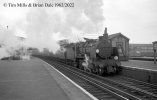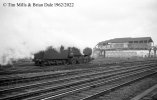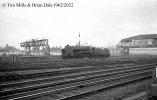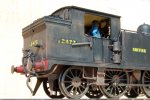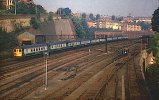The thing is, Dave, if god had intended us to fly she'd have given us wings....
Then, Martin, my apologies for getting the N wrong! I really should now by now not to rely absolutely on Tim's notes... Thanks too for your info regarding Weymouth shed. I remember Weymouth for two reasons. One was the tramway to the Channel Islands ferries where I saw and photographed one of the 1366 class pannier tanks on a boat train, (and interestingly for me from the same spot where we pick up the boat at Weymouth when I go fishing) and also where I saw the last Merchant Navy to complete my set- Ellerman Lines. Finally thanks for yours about the train staff. All interesting stuff.
And by way of the train staff to Brian who stimulated the reply from Martin and Dave's photo of a lovely 7mm E4. But mainly thank you for the info about that coaching stock. This detail really fills information which was never recorded.
Finally David and your observation about the Pullman Works photo. At this distance in time who knows the answer? And also to Tim for the further observation.
E4 0-6-2T 32557 on empty stock at Waterloo on 15th November 1962. We've seen this loco a lot recently, for example in posts #2544 and #3401. Although a Brighton engine by design it had moved to Nine Elms in November 1961. It was withdrawn in December 1962. (SLS). It was scrapped at Eastleigh Works by the end of October 1963. (Rail UK).
It is interesting to note that, despite the "official" allocation shown above the loco is clearly carrying a 73B Bricklayers Arms shed plate which, according to the SLS it left in November 1961 to go to Nine Elms.
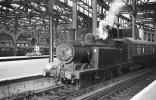
Is this photo unique? Three locos from three different companies alongside one another and working on the Southern. As remarked previously there were a few GWR 57XX pannier tanks allocated to the SR intended as replacements for the M7s. This is 4698 (GWR) with E4 32557 (LBSCR) and M7 30034 (LSWR) at Waterloo on 15th November 1962. 4698 was loaned to Nine Elms initially in March 1959 but must have been regarded as satisfactory as it was allocated there at the end of June the same year. In July 1963 it moved to Treherbert, then Gloucester Horton Road at the end of August the same year, Bristol Barrow Road in May 1964 and finally back to Gloucester Horton Road in October where it was withdrawn in November 1965. (SLS). WHTS record it as at Ward’s, Briton Ferry, in January 1966 and BR Database that scrapping occurred in February 1966.
32557 has featured a lot recently but for reference see posts #2544 and #3401. It had moved to Nine Elms in November 1961 and was withdrawn in December 1962. (SLS). It was scrapped at Eastleigh Works by the end of October 1963. (Rail UK).
30034 was a Nine Elms engine from July 1962, moving to Salisbury notionally in September 1962 but clearly still in London in November. It was withdrawn from Salisbury in February 1963 so I wonder if it ever actually got there. (SLS). It was cut up at Eastleigh Works week ending 25th May 1963. (RO).
There's a Pullman Car edging in to the right hand side of this shot so I wonder if the pannier tank is bringing in the empty stock for the Bournemouth Belle.
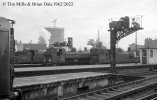
Rebuilt Merchant Navy pacific 35013 Blue Funnel light engine at Waterloo on 15th November 1962. At the time this was an Exmouth Junction engine and had been since March 1954. It went to Bournemouth in September 1964, Weymouth Radipole in October 1966 and finally Nine Elms in April 1967 where it lasted almost to the end of Southern steam being withdrawn on 2nd July 1967. WHTS reported it at Buttigeig’s, Newport at the end of March 1968 where it was scrapped in April 1968 according to BR Database.
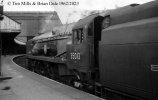
Brian

